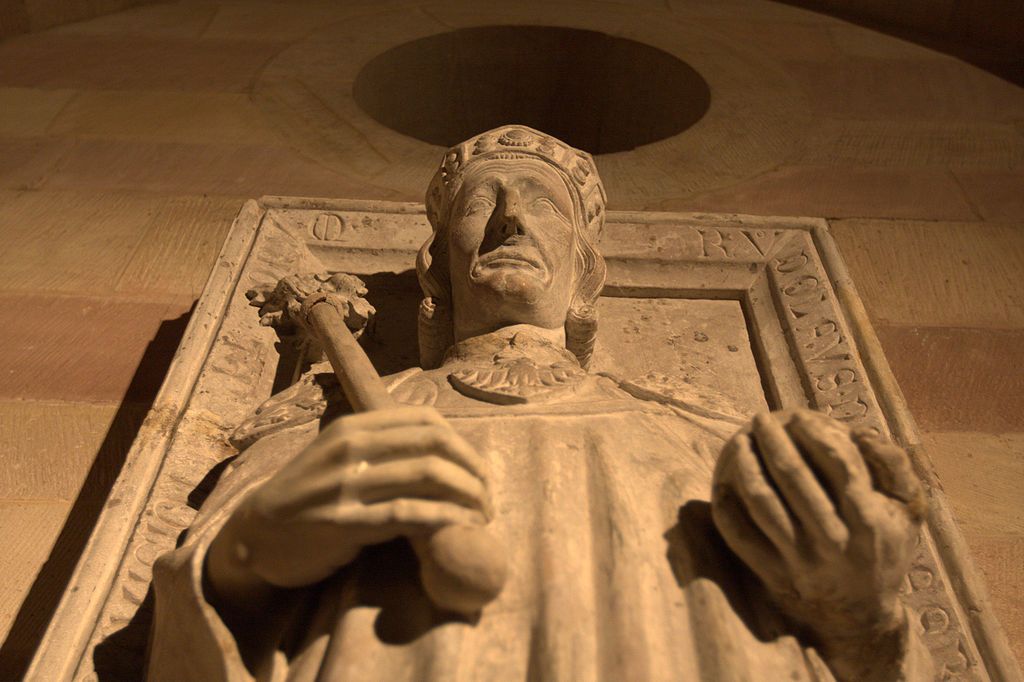5-minute News Cutaway:
MUSIC TRACK
Ensemble Masques directed by harpsichordist Oliver Fortin. We heard “Al giorno delle Correggie” by Johann Henrich Schmelzer. (:10)
Segment A:
Music was part of court life from the very start of Habsburg rule over the Holy Roman Empire. Rudolf I (r who was the first King of the Romans in the Habsburg family, ruled in the late 13th century. He welcomed musicians in his court, including the minnesinger Heinrich Frauenlob. Here is “Die kuniginne von saba” (the queen of Sheeba). The text is attributed to Frauenlob.
MUSIC TRACK
We heard “Die kuniginne von saba”, from a CD of music by the German Minnesinger Frauenlob, by singer Sabine Lutzenberger and flutist Norbert Rodenkirchen.
Rudolf the second was known for some political missteps just before the 30 Years War—but he was a patron of the arts, and his support of the arts and collection of curiosities gives us some insight into the rich mannerist art, and scientific and musical instruments, of the late sixteenth century. Flemish composer Jacob Regnart worked in Rudolf’s court. Let’s hear one of Regnart’s secular German songs, “Venus du und dein Kind” -- music from the Habsburg court of Rudolf II.
MUSIC TRACK
We heard “Venus du und dein Kind,” by Jacob Regnart. That was the Viennese ensemble Cinquecento on their 2014 Hyperion release, “Amorosi Pensieri: songs for the Habsburg court.”
During his lifetime, Regnart’s music was regarded so highly that Orlando de Lassus tried to whisk him away to work for the court in Saxony, but Regnart decided to continue working for the Habsburg court instead. Next, we’ll hear one of Regnart’s sacred works: “Lamentabatur Jacob.” In this work, Jacob laments his sons Joseph and Benjamin being taken into captivity in Egypt. Regnart may have been familiar with Cristóbal Morales’ setting, written for the Sistine chapel in the 1540s.
MUSIC TRACK
“Lamentabatur Jacob,” sung by the vocal ensemble Cinquecento, with music by Jacob Regnart.
Under the rule of the Habsburg Emperor Ferdinand the Third, the Thirty Years War ended with the Peace of Westphalia. In addition to his political triumphs and failures, Ferdinand was fond of music. He showed his affection through a lifetime of compositional study and patronage. Here is the emperor’s setting of hymn “Jesu Corona Virginum.”
MUSIC TRACK
The Hymn “Jesu Corona Virginum,” set by Ferdinand III, Holy Roman Emperor. We heard Franz Vitzhum, countertenor, with Les Escapades viol consort.
Our playlists, podcasts, and archived episodes are online at harmonia early music dot org.
You can follow our Facebook page and our updates on Twitter by searching for Harmonia Early Music.
Midpoint break:
Harmonia is a program of early music that comes to you from the studios of WFIU at Indiana University. Partial support for Harmonia comes from PENN-CO incorporated of Bedford, Indiana. Partial support also comes from Early Music America, fostering the performance, scholarship, and community of early music…on the web at EarlyMusicAmerica-DOT-org. I’m Angela Mariani.
One-minute Music Break"
MUSIC TRACK
Segment B:
Welcome back. We’ve been listening to music composed under the rule of three of the Habsburg emperors. Ferdinand the Third was especially close with German composer Johann Jakob Froberger. Upon Ferdinand’s death, Froberger wrote this Lamentation. The work unfolds slowly, almost painfully, as Froberger recounts the pain of losing his friend. Performance indications suggest “avec discretion,” with freedom. One account indicated that Froberger wrote this piece in a “very clear” way and that it was unfortunate the pieces were subject to quote “massacre.” This warning against leeway in tempo is still lost on modern performers. In this recording, the Lamentation takes five minutes, but on another recording we considered, the piece takes 12 minutes.
MUSIC TRACK
Froberger’s Lamentation on the death of Ferdinand III. We heard Glen Wilson, harpsichord, on that Naxos 2016 release, “Johann Jacob Froberger: 23 Suites for Harpsichord.”
Violinist and composer Johann Henirich Schmelzer also wrote a lamentation for Ferdinand III; it’s among the earliest surviving works by Schmelzer. Instead of featuring a lonely harpsichord, Schmelzer’s setting requires an ensemble. In this recording, we’ll hear baroque strings and organ from Ensemble Masques.
MUSIC TRACK
The “Lament on the death of Ferdinand the Third,” by Johann Henrich Schmelzer. Ensemble Masques was directed by harpsichordist Oliver Fortin, from a recording entitled Schmelzer: Sacra Profanus.
In their premiere recording, Ensemble Les Ordinaires performs chamber music from the court of Louis XIV. The ensemble is based in Indiana, where they have performed at Twin Cities Early Music Festival and in 18th and early 19th century spaces in Indiana and Kentucky. First, we’ll hear a “Brunette” by late baroque composer Jacques-Martin Hotteterre. These highly ornamented pieces for flute and continuo mimic the tradition of vocalists from the same time, who sang airs and brunettes about unrequited love in bucolic settings. Here is “Rochers, je ne veux point ‘Air de Bacilly’.”
MUSIC TRACK
Music from Hotteterre’s “Airs et brunettes pour les traversières” performed by Les ordinaires featuring flutist Leela Breithaupt on the 2018 Naxos release, Inner Chambers: Royal Court Music of Louis XIV.
Marin Marais’ Piecès de viole, published in Paris in 1711, represents core works of a favorite instrument of the French aristocracy: the viola da gamba. Here are gambist Erica Rubis and theorbo player David Walker performing two movements from Marais’ third book of viol pieces.
MUSIC TRACK
“Sarabande” and “La Guitare” from Marin Marais’s Pièces de viole Performed by Les Ordinaires.
We’ll close with an elegant Chaconne from Jean-Baptiste Lully’s “Trios de la Chambre ‘pour le Coucher du Roi.”
MUSIC TRACK
The Chaconne from Lully’s Trios de la Chambre ‘pour le Coucher du Roi,’ performed by Les Ordinaires.
END OF SEGMENT B:
More music, stories, history, recordings, and other information about the world of early music can be found on our Harmonia Early Music Podcasts, online at harmonia early music dot org and through iTunes. You’re listening to Harmonia.
CONCLUSION
Harmonia is a production of WFIU, and part of the educational mission of Indiana University. Additional resources come from the William and Gayle Cook Music Library at the Indiana University Jacobs School of Music.
We welcome your thoughts about any part of this program, or about early music in general. You can leave a comment or question any time by visiting harmonia early music dot org and clicking on "Contact."
The writer for this edition of Harmonia was Sarah Schilling.
Thanks to our studio engineer Michael Paskash and our staff – Wendy Gillespie and LuAnn Johnson. Additional technical support comes from KTTZ at Texas Tech University in Lubbock, Texas.
Our producer is Elizabeth Clark, our executive producer is John Bailey, and I’m Angela Mariani, inviting you to join us again for the next edition of Harmonia.










